MGMT1102: Corporate Social Responsibility Final Exam - Winter 2019
VerifiedAdded on 2023/01/19
|6
|1696
|43
Homework Assignment
AI Summary
This assignment explores key concepts in Corporate Social Responsibility (CSR). It begins by defining responsiveness in the Age of Responsibility, providing examples and discussing the trade-off between responsiveness and scalability. The assignment then delves into the concept of glocality, explaining its application to products and services, and outlining the benefits for businesses. Finally, it examines the key drivers in the Age of Responsibility, as identified by Wayne Visser, analyzing the factors causing companies to prioritize sustainability and the consequences of ignoring it. The assignment draws on academic sources and provides real-world examples to illustrate the concepts discussed, offering a comprehensive overview of CSR principles and their practical implications. The assignment is based on a final exam for the MGMT1102 Corporate Social Responsibility course, Winter 2019.
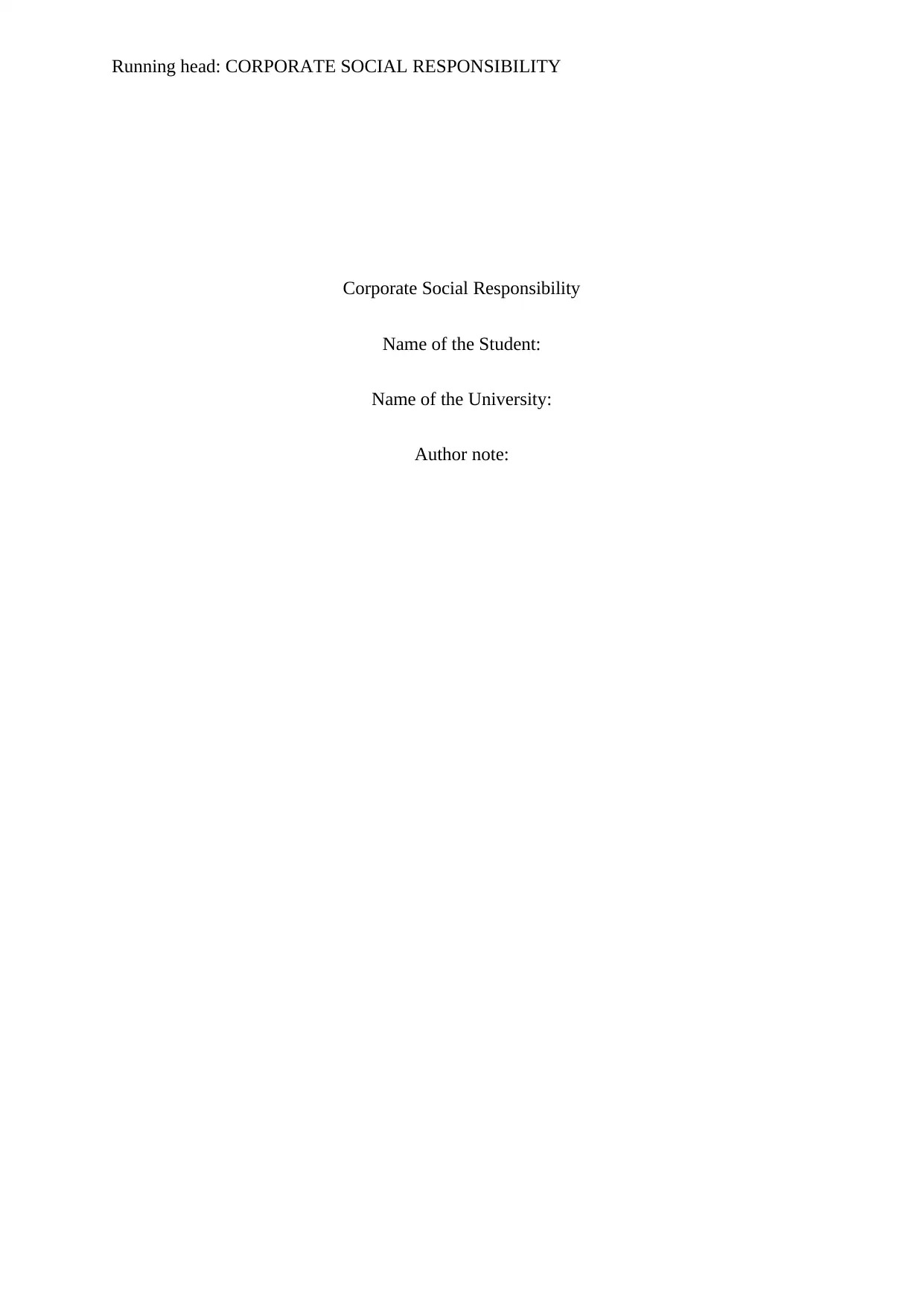
Running head: CORPORATE SOCIAL RESPONSIBILITY
Corporate Social Responsibility
Name of the Student:
Name of the University:
Author note:
Corporate Social Responsibility
Name of the Student:
Name of the University:
Author note:
Paraphrase This Document
Need a fresh take? Get an instant paraphrase of this document with our AI Paraphraser
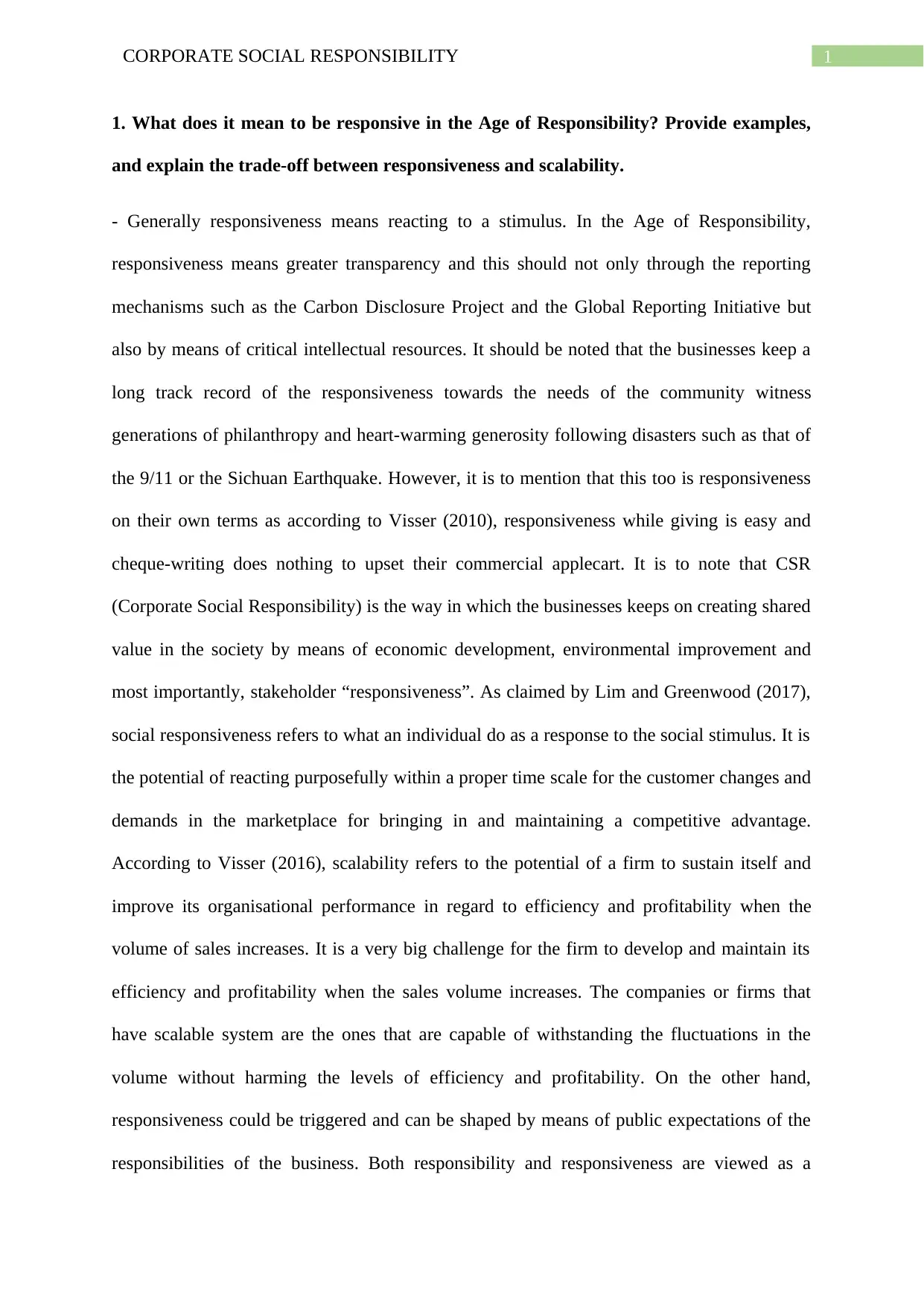
1CORPORATE SOCIAL RESPONSIBILITY
1. What does it mean to be responsive in the Age of Responsibility? Provide examples,
and explain the trade-off between responsiveness and scalability.
- Generally responsiveness means reacting to a stimulus. In the Age of Responsibility,
responsiveness means greater transparency and this should not only through the reporting
mechanisms such as the Carbon Disclosure Project and the Global Reporting Initiative but
also by means of critical intellectual resources. It should be noted that the businesses keep a
long track record of the responsiveness towards the needs of the community witness
generations of philanthropy and heart-warming generosity following disasters such as that of
the 9/11 or the Sichuan Earthquake. However, it is to mention that this too is responsiveness
on their own terms as according to Visser (2010), responsiveness while giving is easy and
cheque-writing does nothing to upset their commercial applecart. It is to note that CSR
(Corporate Social Responsibility) is the way in which the businesses keeps on creating shared
value in the society by means of economic development, environmental improvement and
most importantly, stakeholder “responsiveness”. As claimed by Lim and Greenwood (2017),
social responsiveness refers to what an individual do as a response to the social stimulus. It is
the potential of reacting purposefully within a proper time scale for the customer changes and
demands in the marketplace for bringing in and maintaining a competitive advantage.
According to Visser (2016), scalability refers to the potential of a firm to sustain itself and
improve its organisational performance in regard to efficiency and profitability when the
volume of sales increases. It is a very big challenge for the firm to develop and maintain its
efficiency and profitability when the sales volume increases. The companies or firms that
have scalable system are the ones that are capable of withstanding the fluctuations in the
volume without harming the levels of efficiency and profitability. On the other hand,
responsiveness could be triggered and can be shaped by means of public expectations of the
responsibilities of the business. Both responsibility and responsiveness are viewed as a
1. What does it mean to be responsive in the Age of Responsibility? Provide examples,
and explain the trade-off between responsiveness and scalability.
- Generally responsiveness means reacting to a stimulus. In the Age of Responsibility,
responsiveness means greater transparency and this should not only through the reporting
mechanisms such as the Carbon Disclosure Project and the Global Reporting Initiative but
also by means of critical intellectual resources. It should be noted that the businesses keep a
long track record of the responsiveness towards the needs of the community witness
generations of philanthropy and heart-warming generosity following disasters such as that of
the 9/11 or the Sichuan Earthquake. However, it is to mention that this too is responsiveness
on their own terms as according to Visser (2010), responsiveness while giving is easy and
cheque-writing does nothing to upset their commercial applecart. It is to note that CSR
(Corporate Social Responsibility) is the way in which the businesses keeps on creating shared
value in the society by means of economic development, environmental improvement and
most importantly, stakeholder “responsiveness”. As claimed by Lim and Greenwood (2017),
social responsiveness refers to what an individual do as a response to the social stimulus. It is
the potential of reacting purposefully within a proper time scale for the customer changes and
demands in the marketplace for bringing in and maintaining a competitive advantage.
According to Visser (2016), scalability refers to the potential of a firm to sustain itself and
improve its organisational performance in regard to efficiency and profitability when the
volume of sales increases. It is a very big challenge for the firm to develop and maintain its
efficiency and profitability when the sales volume increases. The companies or firms that
have scalable system are the ones that are capable of withstanding the fluctuations in the
volume without harming the levels of efficiency and profitability. On the other hand,
responsiveness could be triggered and can be shaped by means of public expectations of the
responsibilities of the business. Both responsibility and responsiveness are viewed as a
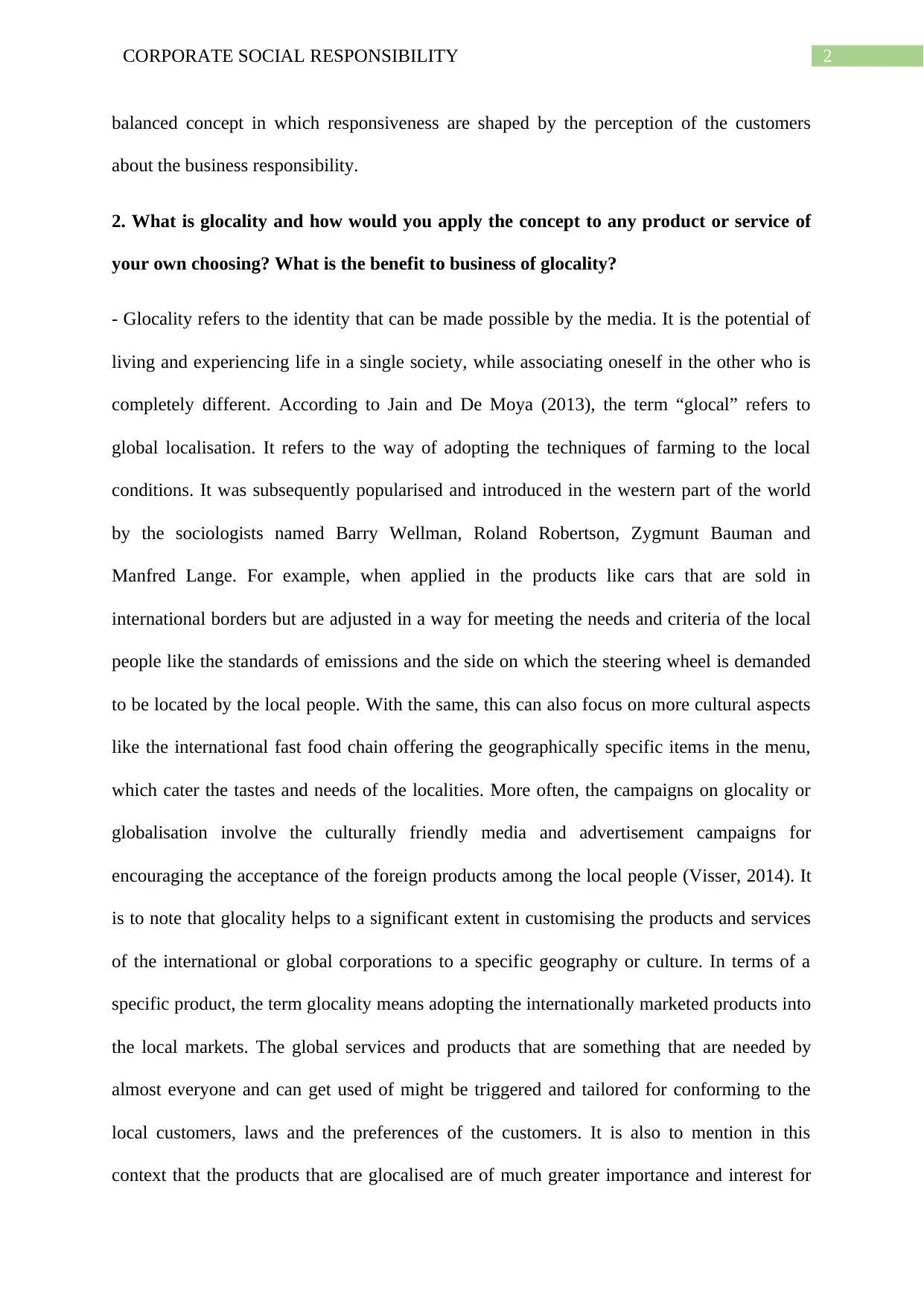
2CORPORATE SOCIAL RESPONSIBILITY
balanced concept in which responsiveness are shaped by the perception of the customers
about the business responsibility.
2. What is glocality and how would you apply the concept to any product or service of
your own choosing? What is the benefit to business of glocality?
- Glocality refers to the identity that can be made possible by the media. It is the potential of
living and experiencing life in a single society, while associating oneself in the other who is
completely different. According to Jain and De Moya (2013), the term “glocal” refers to
global localisation. It refers to the way of adopting the techniques of farming to the local
conditions. It was subsequently popularised and introduced in the western part of the world
by the sociologists named Barry Wellman, Roland Robertson, Zygmunt Bauman and
Manfred Lange. For example, when applied in the products like cars that are sold in
international borders but are adjusted in a way for meeting the needs and criteria of the local
people like the standards of emissions and the side on which the steering wheel is demanded
to be located by the local people. With the same, this can also focus on more cultural aspects
like the international fast food chain offering the geographically specific items in the menu,
which cater the tastes and needs of the localities. More often, the campaigns on glocality or
globalisation involve the culturally friendly media and advertisement campaigns for
encouraging the acceptance of the foreign products among the local people (Visser, 2014). It
is to note that glocality helps to a significant extent in customising the products and services
of the international or global corporations to a specific geography or culture. In terms of a
specific product, the term glocality means adopting the internationally marketed products into
the local markets. The global services and products that are something that are needed by
almost everyone and can get used of might be triggered and tailored for conforming to the
local customers, laws and the preferences of the customers. It is also to mention in this
context that the products that are glocalised are of much greater importance and interest for
balanced concept in which responsiveness are shaped by the perception of the customers
about the business responsibility.
2. What is glocality and how would you apply the concept to any product or service of
your own choosing? What is the benefit to business of glocality?
- Glocality refers to the identity that can be made possible by the media. It is the potential of
living and experiencing life in a single society, while associating oneself in the other who is
completely different. According to Jain and De Moya (2013), the term “glocal” refers to
global localisation. It refers to the way of adopting the techniques of farming to the local
conditions. It was subsequently popularised and introduced in the western part of the world
by the sociologists named Barry Wellman, Roland Robertson, Zygmunt Bauman and
Manfred Lange. For example, when applied in the products like cars that are sold in
international borders but are adjusted in a way for meeting the needs and criteria of the local
people like the standards of emissions and the side on which the steering wheel is demanded
to be located by the local people. With the same, this can also focus on more cultural aspects
like the international fast food chain offering the geographically specific items in the menu,
which cater the tastes and needs of the localities. More often, the campaigns on glocality or
globalisation involve the culturally friendly media and advertisement campaigns for
encouraging the acceptance of the foreign products among the local people (Visser, 2014). It
is to note that glocality helps to a significant extent in customising the products and services
of the international or global corporations to a specific geography or culture. In terms of a
specific product, the term glocality means adopting the internationally marketed products into
the local markets. The global services and products that are something that are needed by
almost everyone and can get used of might be triggered and tailored for conforming to the
local customers, laws and the preferences of the customers. It is also to mention in this
context that the products that are glocalised are of much greater importance and interest for
⊘ This is a preview!⊘
Do you want full access?
Subscribe today to unlock all pages.

Trusted by 1+ million students worldwide
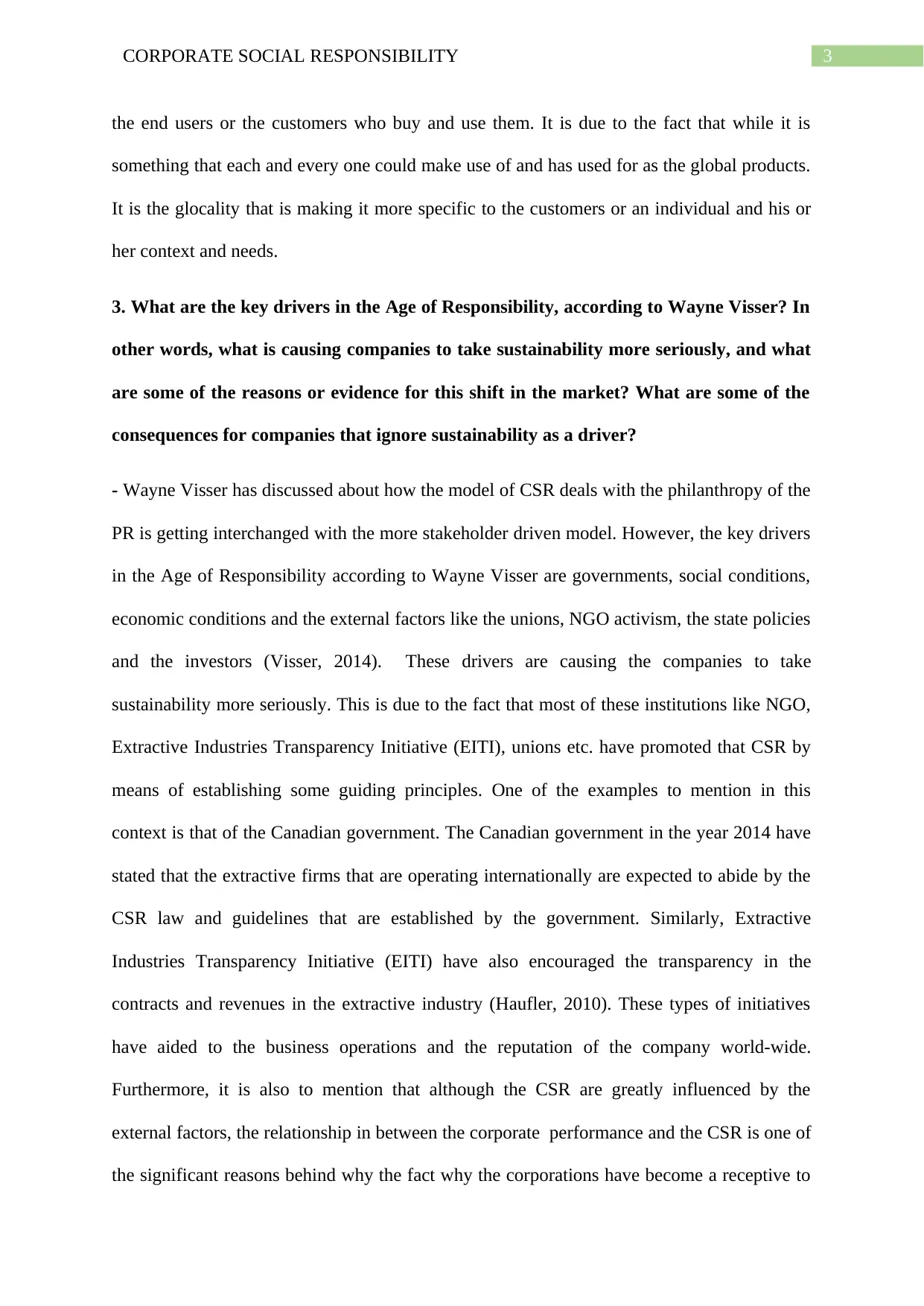
3CORPORATE SOCIAL RESPONSIBILITY
the end users or the customers who buy and use them. It is due to the fact that while it is
something that each and every one could make use of and has used for as the global products.
It is the glocality that is making it more specific to the customers or an individual and his or
her context and needs.
3. What are the key drivers in the Age of Responsibility, according to Wayne Visser? In
other words, what is causing companies to take sustainability more seriously, and what
are some of the reasons or evidence for this shift in the market? What are some of the
consequences for companies that ignore sustainability as a driver?
- Wayne Visser has discussed about how the model of CSR deals with the philanthropy of the
PR is getting interchanged with the more stakeholder driven model. However, the key drivers
in the Age of Responsibility according to Wayne Visser are governments, social conditions,
economic conditions and the external factors like the unions, NGO activism, the state policies
and the investors (Visser, 2014). These drivers are causing the companies to take
sustainability more seriously. This is due to the fact that most of these institutions like NGO,
Extractive Industries Transparency Initiative (EITI), unions etc. have promoted that CSR by
means of establishing some guiding principles. One of the examples to mention in this
context is that of the Canadian government. The Canadian government in the year 2014 have
stated that the extractive firms that are operating internationally are expected to abide by the
CSR law and guidelines that are established by the government. Similarly, Extractive
Industries Transparency Initiative (EITI) have also encouraged the transparency in the
contracts and revenues in the extractive industry (Haufler, 2010). These types of initiatives
have aided to the business operations and the reputation of the company world-wide.
Furthermore, it is also to mention that although the CSR are greatly influenced by the
external factors, the relationship in between the corporate performance and the CSR is one of
the significant reasons behind why the fact why the corporations have become a receptive to
the end users or the customers who buy and use them. It is due to the fact that while it is
something that each and every one could make use of and has used for as the global products.
It is the glocality that is making it more specific to the customers or an individual and his or
her context and needs.
3. What are the key drivers in the Age of Responsibility, according to Wayne Visser? In
other words, what is causing companies to take sustainability more seriously, and what
are some of the reasons or evidence for this shift in the market? What are some of the
consequences for companies that ignore sustainability as a driver?
- Wayne Visser has discussed about how the model of CSR deals with the philanthropy of the
PR is getting interchanged with the more stakeholder driven model. However, the key drivers
in the Age of Responsibility according to Wayne Visser are governments, social conditions,
economic conditions and the external factors like the unions, NGO activism, the state policies
and the investors (Visser, 2014). These drivers are causing the companies to take
sustainability more seriously. This is due to the fact that most of these institutions like NGO,
Extractive Industries Transparency Initiative (EITI), unions etc. have promoted that CSR by
means of establishing some guiding principles. One of the examples to mention in this
context is that of the Canadian government. The Canadian government in the year 2014 have
stated that the extractive firms that are operating internationally are expected to abide by the
CSR law and guidelines that are established by the government. Similarly, Extractive
Industries Transparency Initiative (EITI) have also encouraged the transparency in the
contracts and revenues in the extractive industry (Haufler, 2010). These types of initiatives
have aided to the business operations and the reputation of the company world-wide.
Furthermore, it is also to mention that although the CSR are greatly influenced by the
external factors, the relationship in between the corporate performance and the CSR is one of
the significant reasons behind why the fact why the corporations have become a receptive to
Paraphrase This Document
Need a fresh take? Get an instant paraphrase of this document with our AI Paraphraser
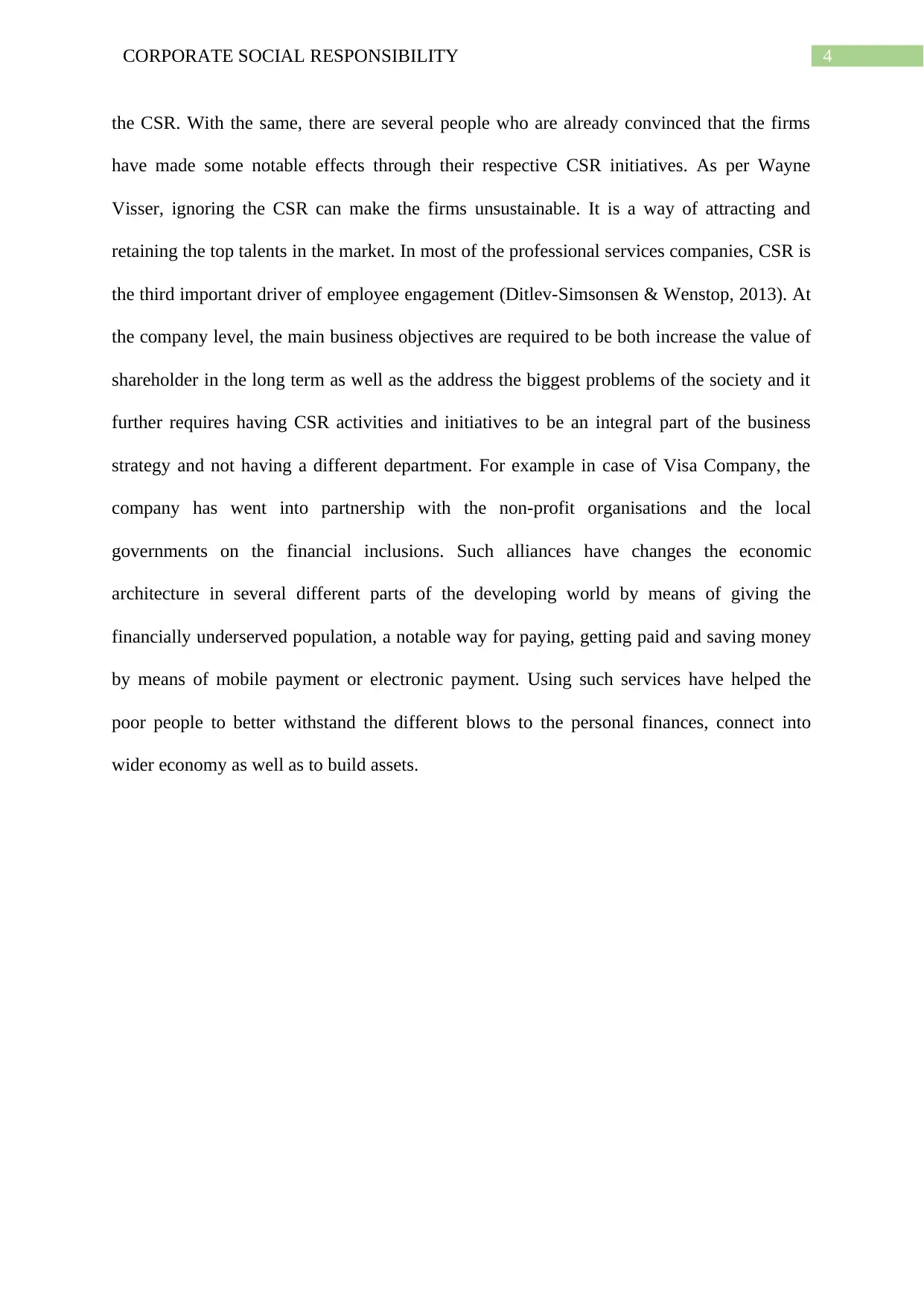
4CORPORATE SOCIAL RESPONSIBILITY
the CSR. With the same, there are several people who are already convinced that the firms
have made some notable effects through their respective CSR initiatives. As per Wayne
Visser, ignoring the CSR can make the firms unsustainable. It is a way of attracting and
retaining the top talents in the market. In most of the professional services companies, CSR is
the third important driver of employee engagement (Ditlev-Simsonsen & Wenstop, 2013). At
the company level, the main business objectives are required to be both increase the value of
shareholder in the long term as well as the address the biggest problems of the society and it
further requires having CSR activities and initiatives to be an integral part of the business
strategy and not having a different department. For example in case of Visa Company, the
company has went into partnership with the non-profit organisations and the local
governments on the financial inclusions. Such alliances have changes the economic
architecture in several different parts of the developing world by means of giving the
financially underserved population, a notable way for paying, getting paid and saving money
by means of mobile payment or electronic payment. Using such services have helped the
poor people to better withstand the different blows to the personal finances, connect into
wider economy as well as to build assets.
the CSR. With the same, there are several people who are already convinced that the firms
have made some notable effects through their respective CSR initiatives. As per Wayne
Visser, ignoring the CSR can make the firms unsustainable. It is a way of attracting and
retaining the top talents in the market. In most of the professional services companies, CSR is
the third important driver of employee engagement (Ditlev-Simsonsen & Wenstop, 2013). At
the company level, the main business objectives are required to be both increase the value of
shareholder in the long term as well as the address the biggest problems of the society and it
further requires having CSR activities and initiatives to be an integral part of the business
strategy and not having a different department. For example in case of Visa Company, the
company has went into partnership with the non-profit organisations and the local
governments on the financial inclusions. Such alliances have changes the economic
architecture in several different parts of the developing world by means of giving the
financially underserved population, a notable way for paying, getting paid and saving money
by means of mobile payment or electronic payment. Using such services have helped the
poor people to better withstand the different blows to the personal finances, connect into
wider economy as well as to build assets.
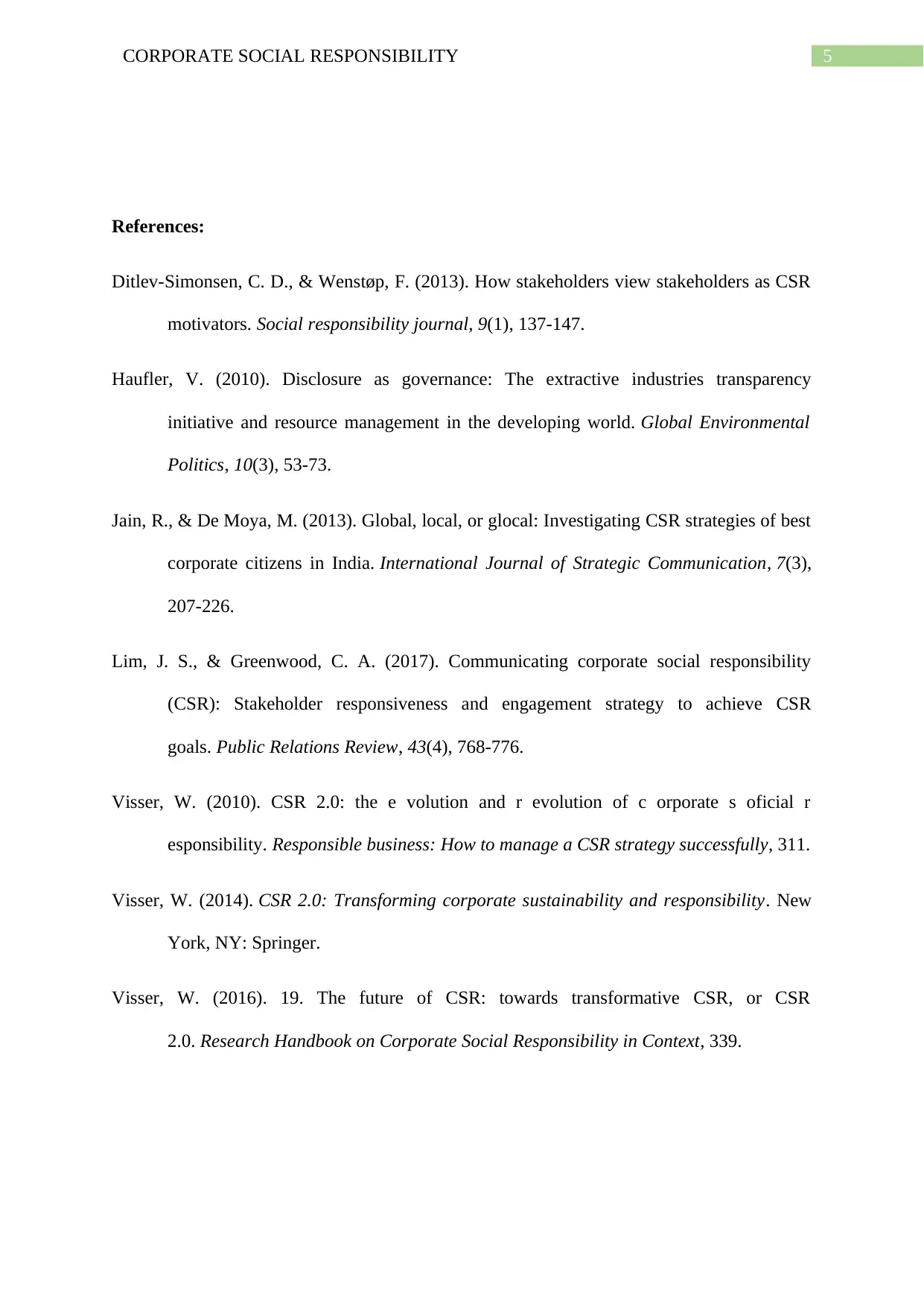
5CORPORATE SOCIAL RESPONSIBILITY
References:
Ditlev-Simonsen, C. D., & Wenstøp, F. (2013). How stakeholders view stakeholders as CSR
motivators. Social responsibility journal, 9(1), 137-147.
Haufler, V. (2010). Disclosure as governance: The extractive industries transparency
initiative and resource management in the developing world. Global Environmental
Politics, 10(3), 53-73.
Jain, R., & De Moya, M. (2013). Global, local, or glocal: Investigating CSR strategies of best
corporate citizens in India. International Journal of Strategic Communication, 7(3),
207-226.
Lim, J. S., & Greenwood, C. A. (2017). Communicating corporate social responsibility
(CSR): Stakeholder responsiveness and engagement strategy to achieve CSR
goals. Public Relations Review, 43(4), 768-776.
Visser, W. (2010). CSR 2.0: the e volution and r evolution of c orporate s oficial r
esponsibility. Responsible business: How to manage a CSR strategy successfully, 311.
Visser, W. (2014). CSR 2.0: Transforming corporate sustainability and responsibility. New
York, NY: Springer.
Visser, W. (2016). 19. The future of CSR: towards transformative CSR, or CSR
2.0. Research Handbook on Corporate Social Responsibility in Context, 339.
References:
Ditlev-Simonsen, C. D., & Wenstøp, F. (2013). How stakeholders view stakeholders as CSR
motivators. Social responsibility journal, 9(1), 137-147.
Haufler, V. (2010). Disclosure as governance: The extractive industries transparency
initiative and resource management in the developing world. Global Environmental
Politics, 10(3), 53-73.
Jain, R., & De Moya, M. (2013). Global, local, or glocal: Investigating CSR strategies of best
corporate citizens in India. International Journal of Strategic Communication, 7(3),
207-226.
Lim, J. S., & Greenwood, C. A. (2017). Communicating corporate social responsibility
(CSR): Stakeholder responsiveness and engagement strategy to achieve CSR
goals. Public Relations Review, 43(4), 768-776.
Visser, W. (2010). CSR 2.0: the e volution and r evolution of c orporate s oficial r
esponsibility. Responsible business: How to manage a CSR strategy successfully, 311.
Visser, W. (2014). CSR 2.0: Transforming corporate sustainability and responsibility. New
York, NY: Springer.
Visser, W. (2016). 19. The future of CSR: towards transformative CSR, or CSR
2.0. Research Handbook on Corporate Social Responsibility in Context, 339.
⊘ This is a preview!⊘
Do you want full access?
Subscribe today to unlock all pages.

Trusted by 1+ million students worldwide
1 out of 6
Related Documents
Your All-in-One AI-Powered Toolkit for Academic Success.
+13062052269
info@desklib.com
Available 24*7 on WhatsApp / Email
![[object Object]](/_next/static/media/star-bottom.7253800d.svg)
Unlock your academic potential
Copyright © 2020–2025 A2Z Services. All Rights Reserved. Developed and managed by ZUCOL.



